Ceramic Inks Market Size
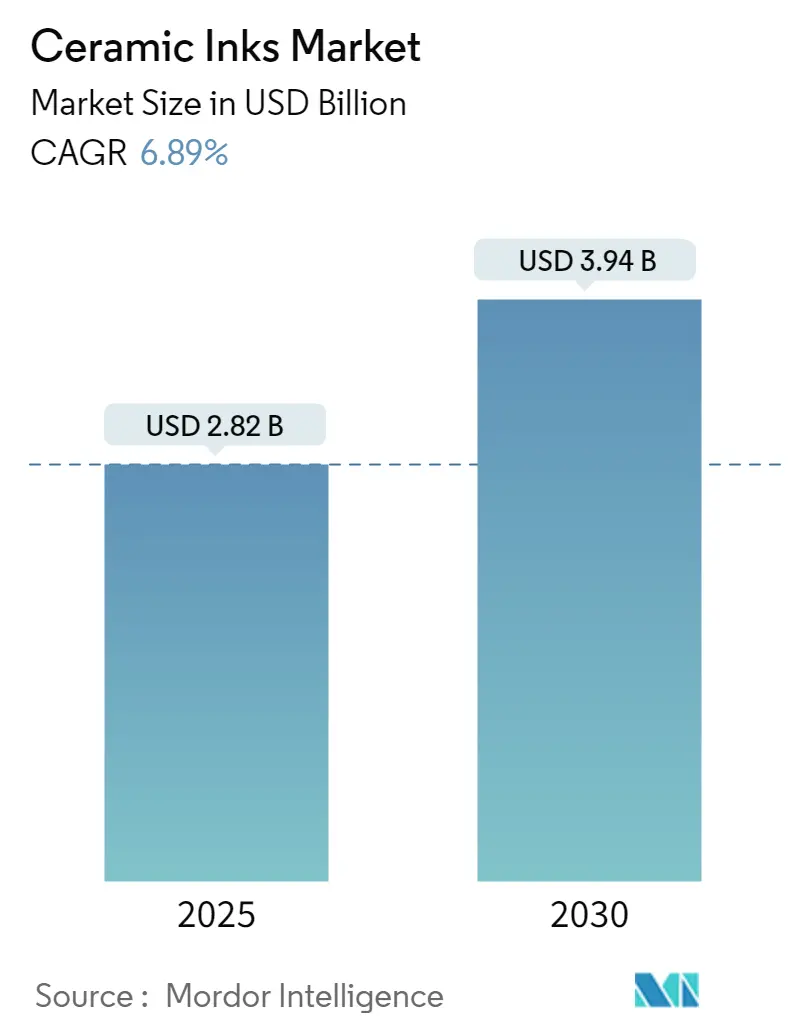
| Study Period | 2019 - 2030 |
| Market Size (2025) | USD 2.82 Billion |
| Market Size (2030) | USD 3.94 Billion |
| CAGR (2025 - 2030) | 6.89 % |
| Fastest Growing Market | Asia Pacific |
| Largest Market | Asia Pacific |
| Market Concentration | Low |
Major Players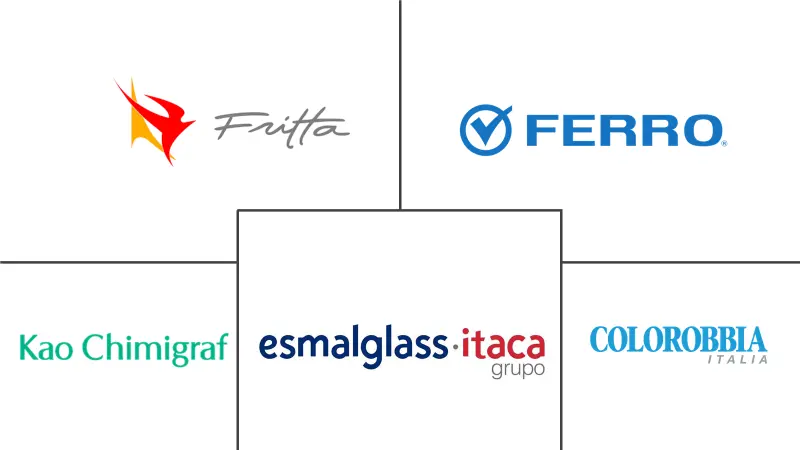
*Disclaimer: Major Players sorted in no particular order |
Ceramic Inks Market Analysis
The Ceramic Inks Market size is estimated at USD 2.82 billion in 2025, and is expected to reach USD 3.94 billion by 2030, at a CAGR of 6.89% during the forecast period (2025-2030).
The COVID-19 pandemic negatively impacted the market. It was because of the shutdown of the manufacturing facilities and plants due to the lockdown and restrictions. Supply chain and transportation disruptions further created hindrances for the market. However, the industry witnessed a recovery in 2021, thus rebounding the demand for the market studied.
- Over the short term, increasing demand for decorative glass and tiles are some factors driving the studied market's growth.
- Conversely, high-cost involvement in shifting from analog to digital technology will likely hinder the market's growth.
- However, technological advancements in digital printing are projected to act as an opportunity for the market shortly.
- Asia-Pacific is expected to dominate the global ceramic ink market during the forecast period.
Ceramic Inks Market Trends
Ceramic Tiles is the Fastest Growing Segment
- The fastest-growing application of the ceramic ink market is ceramic tiles. There is a need to improve the aesthetics of buildings to address the functional requirement of the customers.
- Ceramic tiles became the most popular materials that are being used, owing to properties such as high durability, resistance to wear, color permanence, etc.
- Over the past few years, there is a significant increase in residential construction spending, owing to which there is a rise in the demand for ceramic tiles across the globe. For instance, according to a study by the Institution of Civil Engineers (ICE), the global construction industry is expected to reach USD 8 trillion by 2030, primarily driven by China, India, and the United States. Therefore, the growing construction industry is expected to include an upside demand for ceramic tiles which further will boost the demand for ceramic inks market in the coming years.
- India is anticipated to remain the fastest-growing G20 economy in the Asia-Pacific region. The Indian government announced a target of USD 376.5 billion in infrastructure investment over three years (2023-2025), including USD 120.5 billion for developing 27 industrial clusters and USD 75.3 billion for road, railway, and port connectivity projects.
- Furthermore, Saudi Arabia is working on many commercial projects, likely leading to more commercial buildings. The USD 500 billion futuristic mega-city "Neom" project, the Red Sea Project - Phase 1, is expected to be completed by 2025 and includes 14 luxury and hyper-luxury hotels with 3,000 rooms spread across five islands and two inland resorts. The resorts include Qiddiya Entertainment City, Amaala - the uber-luxury wellness tourism destination, and Jean Nouvel's Sharaan resort in Al-Ula. Therefore, increasing investments in commercial constructions is expected to create an upside demand for the ceramic inks market.
- These ceramic tiles gained huge demand in the market, especially in developing economies with the changing lifestyle trend and increasing population income. As a result of this, consumers are preferring ceramic tiles over other flooring and wall decoration options.
- It, in turn, is expected to drive the demand for ceramic inks over the forecast period.
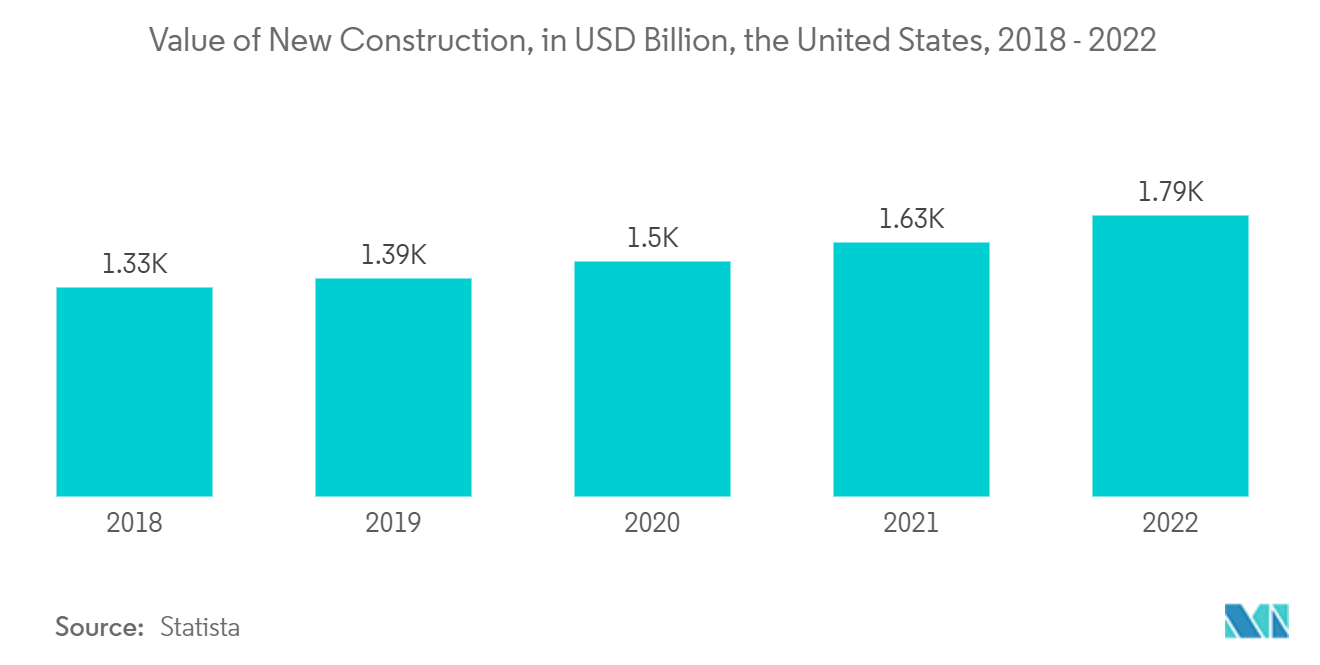
The Asia-Pacific Region is Expected to Lead the Ceramic Inks Market
- The Asia-Pacific region dominated the global market share. With growing investments in residential and commercial construction in the countries such as India, China, the Philippines, Vietnam, and Indonesia, the market for ceramic inks is expected to grow in the coming years.
- China's massive construction sector generated significant demand for ceramic inks. Moreover, China is a huge contributor, as it is one of the leading investors in infrastructure worldwide over the past few years. For instance, according to the National Bureau of Statistics (NBS) of China, in 2022, the output value of construction works in China amounted to CNY 27.63 trillion (USD 4108.581 billion), an increase of 6.6% compared with 2021.
- Moreover, the residential sector in India is on an increasing trend, with government support and initiatives further boosting the demand. According to the India Brand Equity Foundation (IBEF), the Ministry of Housing and Urban Development (MoHUA) allocated USD 9.85 billion in the 2022-2023 budget to construct houses and create funds to complete the halted projects.
- The food printing sector in India includes a large market that involves packaging for the storage and transportation of food. Ceramic inks are widely used in food container printing, glass printing, etc. For instance, according to India Brand Equity Foundation (IBEF), the Indian food processing industry grew rapidly, with an average annual growth rate of 8.3% in the past 5 years.
- Moreover, in 2023, the food-processing market will generate USD 963 billion in revenue, and the market is anticipated to expand at a CAGR of 7.23% between 2023-2027. Therefore, this is expected to create an upside demand for the Ceramic inks market from food packaging.
- Hence, with the increasing demand from the various application segments, the ceramic inks market is expected to grow more in the region during the forecast period.
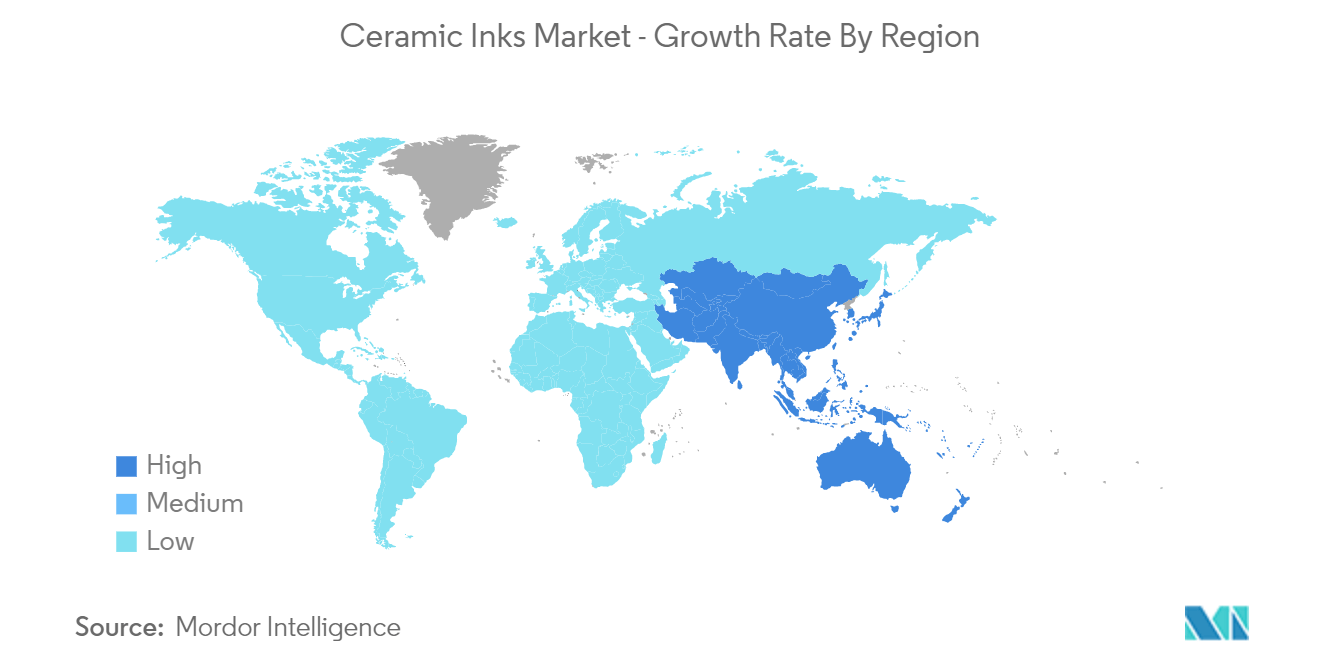
Ceramic Inks Industry Overview
The Ceramic Inks Market is fragmented in nature. The major players in this market (not in a particular order) include Ferro Corporation, FRITTA, Colorobbia Italia SpA, Kao Chimigraf, and Esmalglass-Itaca Grupo.
Ceramic Inks Market Leaders
-
Ferro Corporation
-
FRITTA
-
Colorobbia Italia SpA
-
Kao Chimigraf
-
Esmalglass-Itaca Grupo
*Disclaimer: Major Players sorted in no particular order
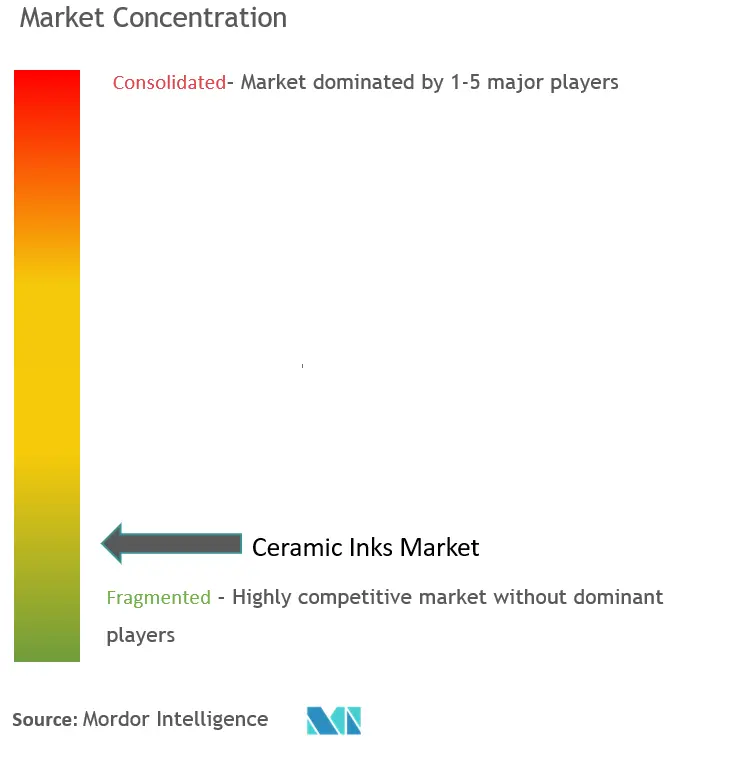
Ceramic Inks Market News
- April 2023: Tecglass, a Spanish glass technology specialist, announced that the company is expanding its manufacturing capacity to meet the growing demand for digital printing solutions. The facility contains the latest equipment for digital printing solutions, which will provide the company with an additional 5000 m2. With this new expansion, now completed and fully operational, Tecglass increased its production floor to a total area of 13,000 m2.
- May 2022: The Colorobbia Group launched a new AIR Evolution digital inks series. These high-end products are designed to meet the growing demands for environmental and technical standards.
Ceramic Inks Market Report - Table of Contents
1. INTRODUCTION
1.1 Study Assumptions
1.2 Scope of the Study
2. RESEARCH METHODOLOGY
3. EXECUTIVE SUMMARY
4. MARKET DYNAMICS
4.1 Market Drivers
4.1.1 Increasing Demand for Decorative Glass and Tiles
4.1.2 Rapid Growth in the Construction Sector
4.2 Market Restraints
4.2.1 High-cost Involvement in Shifting of Analog Technology to Digital Technology
4.2.2 Other Restraints
4.3 Industry Value Chain Analysis
4.4 Porter's Five Forces Analysis
4.4.1 Bargaining Power of Suppliers
4.4.2 Bargaining Power of Buyers
4.4.3 Threat of New Entrants
4.4.4 Threat of Substitute Products and Services
4.4.5 Degree of Competition
5. MARKET SEGMENTATION (Market Size in Value)
5.1 Product Type
5.1.1 Functional Inks
5.1.2 Decorative Inks
5.2 Printing Technology
5.2.1 Digital Printing
5.2.2 Analog Printing
5.3 Application
5.3.1 Ceramic Tiles
5.3.1.1 Residential
5.3.1.2 Non-residential
5.3.2 Glass Printing
5.3.3 Food Container Printing
5.3.4 Other Applications
5.4 Geography
5.4.1 Asia-Pacific
5.4.1.1 China
5.4.1.2 India
5.4.1.3 Japan
5.4.1.4 South Korea
5.4.1.5 Rest of Asia-Pacific
5.4.2 North America
5.4.2.1 United States
5.4.2.2 Canada
5.4.2.3 Mexico
5.4.3 Europe
5.4.3.1 Germany
5.4.3.2 United Kingdom
5.4.3.3 France
5.4.3.4 Italy
5.4.3.5 Rest of Europe
5.4.4 South America
5.4.4.1 Brazil
5.4.4.2 Argentina
5.4.4.3 Rest of South America
5.4.5 Middle East and Africa
5.4.5.1 Saudi Arabia
5.4.5.2 South Africa
5.4.5.3 Rest of Middle East and Africa
6. COMPETITIVE LANDSCAPE
6.1 Mergers and Acquisitions, Joint Ventures, Collaborations, and Agreements
6.2 Market Share (%)**/Ranking Analysis
6.3 Strategies Adopted by Leading Players
6.4 Company Profiles
6.4.1 Colorobbia Italia SpA
6.4.2 Esmalglass - Itaca Grupo
6.4.3 Ferro Corporation
6.4.4 FRITTA
6.4.5 INKCID
6.4.6 Kao Chimigraf
6.4.7 Rex-Tone Industries Ltd
6.4.8 Sicer S.P.A.
6.4.9 Sun Chemical
6.4.10 TECGLASS
6.4.11 Torrecid
6.4.12 ZSCHIMMER & SCHWARZ CHEMIE GMBH
- *List Not Exhaustive
7. MARKET OPPORTUNITIES AND FUTURE TRENDS
7.1 Technological Advancements in Digital Printing Methods
7.2 Other Opportunities
Ceramic Inks Industry Segmentation
Ceramic inks are essential carriers for fine-particle metallic oxide pigments (not raw colorants, but preferred stain powders) utilized in automatic application procedures. Depending on the application technique, these materials can be thick and flow like printing ink. Glass printing, ceramic tile printing, and food container printing all require ceramic inks. The market is segmented based on product type, printing technology, application, and geography. The market is segmented by product type into functional and decorative inks. By printing technology, the market is segmented into digital and analog printing. The market is segmented by application into ceramic tiles, glass printing, food container printing, and other applications. The report offers market size and forecasts for 15 countries across major regions. For each segment, market sizing and forecasts are based on revenue (USD) for all the above segments.
| Product Type | |
| Functional Inks | |
| Decorative Inks |
| Printing Technology | |
| Digital Printing | |
| Analog Printing |
| Application | ||||
| ||||
| Glass Printing | ||||
| Food Container Printing | ||||
| Other Applications |
| Geography | |||||||
| |||||||
| |||||||
| |||||||
| |||||||
|
Ceramic Inks Market Research FAQs
How big is the Ceramic Inks Market?
The Ceramic Inks Market size is expected to reach USD 2.82 billion in 2025 and grow at a CAGR of 6.89% to reach USD 3.94 billion by 2030.
What is the current Ceramic Inks Market size?
In 2025, the Ceramic Inks Market size is expected to reach USD 2.82 billion.
Who are the key players in Ceramic Inks Market?
Ferro Corporation, FRITTA, Colorobbia Italia SpA, Kao Chimigraf and Esmalglass-Itaca Grupo are the major companies operating in the Ceramic Inks Market.
Which is the fastest growing region in Ceramic Inks Market?
Asia Pacific is estimated to grow at the highest CAGR over the forecast period (2025-2030).
Which region has the biggest share in Ceramic Inks Market?
In 2025, the Asia Pacific accounts for the largest market share in Ceramic Inks Market.
What years does this Ceramic Inks Market cover, and what was the market size in 2024?
In 2024, the Ceramic Inks Market size was estimated at USD 2.63 billion. The report covers the Ceramic Inks Market historical market size for years: 2019, 2020, 2021, 2022, 2023 and 2024. The report also forecasts the Ceramic Inks Market size for years: 2025, 2026, 2027, 2028, 2029 and 2030.
Ceramic Inks Industry Report
Statistics for the 2025 Ceramic Inks market share, size and revenue growth rate, created by Mordor Intelligence™ Industry Reports. Ceramic Inks analysis includes a market forecast outlook for 2025 to 2030 and historical overview. Get a sample of this industry analysis as a free report PDF download.



